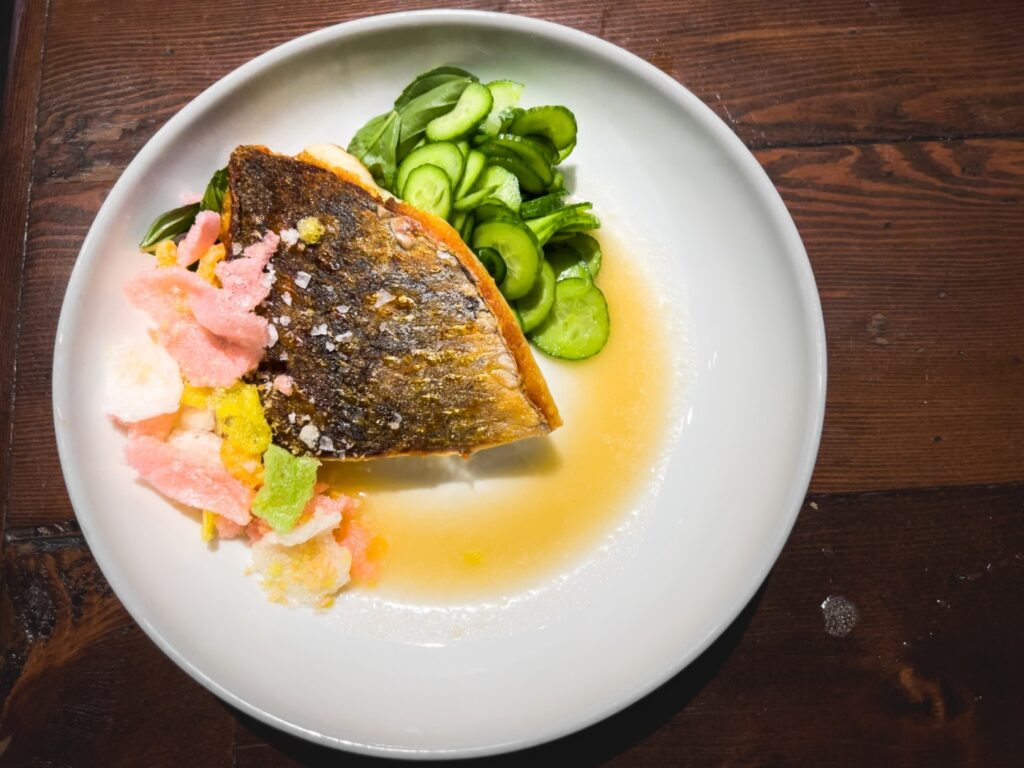
It’s hard to recall a better piece of fish lately than the roasted sea bass at Detention, the restaurant formerly known as Playground in downtown Santa Ana. The skin is crisp and delicate, like a micro layer of chicharron. The flesh underneath feels supple and fatty, it’s flavor unexpectedly mild but also beautifully focused. And here’s the thing: It’s not exactly fresh. It’s been dry-aged for two weeks. That’s what makes it so confounding.
That’s not the only piece of intentionally old fish I’ve eaten recently, either. At Omakase by Gino, an upscale sushi restaurant in Santa Ana, the chef served nigiri sushi made from wild bluefin tuna that he aged for five days using a technique handed down from his grandmother. It was exquisite: clean, pure, not a trace of that fresh minerality that comes with such meaty, red-fleshed fish.
I absolutely loathe fish that smells or tastes super-fishy. I have frequently written about sushi and the importance of freshness. The fresher the fish, the cleaner the taste. Fishiness is usually a sign that the seafood either hasn’t been handled properly or has been dead and out of the water way too long.
One of the best and most memorable experiences that I’ve ever had with raw fish came decades ago on a beach Mexico when a fisherman served me a bowl of ceviche from his boat, a minimalistic ceviche that I watched him craft from a two-foot-long wahoo that he’d just pulled from the sea a few minutes prior. It was an epiphany.
That type of freshness is fleeting. It’s the holy grail. Speed is of the essence. Getting fish into a restaurant kitchen and onto a plate in the first 72 hours is a logistical feat, especially when the fish comes all the way from Japan or the Mediterranean. But even from local waters, that’s not easy.
Related links
New omakase restaurant raises the bar for sushi in Laguna Beach
Same lofty Huntington Beach address, but this is not the same Henry’s
The 10 best new restaurants in Orange County in 2021
French patisserie isn’t easy, and it is rarely as good as this spot in Newport Beach
Gone but not forgotten, 10 closed restaurants I miss the most
So how is it that a two-week-old piece of fish that’s never been frozen can taste so good, so clean, so fresh? It’s because a 14-day dry-aged piece of fish is not the same thing as a two-week-old fish. Most fish is kept on ice, which keeps the skin and flesh wet, often mingling with remnants of blood and itty bits of entrails. That’s what allows fish to begin degrading, even at perfect near-freezing temperatures.
Dry-aging removes the natural moisture from the outside of the fish, along with any blood and impurities that would otherwise contribute to that evolving fishy odor. Much like dry-aging beef, it’s a process that requires a highly controlled environment. And it’s a technique that works best only when the fish is extremely fresh fish to begin with.
That fishy smell dissipates. The flavor shifts. It mellows and softens, allowing the fish’s true character to come into sharper focus. The texture evolves, too, becoming smoother, less flaky and, surprisingly, incredibly moist.
Although fish aging has been practiced in Japan for centuries, it has only recently begun to appear in fine dining restaurants around the world. And while the USDA provides well-established guidelines for dry-aging beef, the FDA (which oversees fish) has yet to take notice of dry-aging fish. We’re still in the wild west stages of this ancient technique’s unexpected rise.
It’s a niche idea that can produce incredible results. It’s also a massive paradigm shift that I’m still trying to get my head around.
Where to find dry-aged fish in OC
Detention
Where: 220 E. 4th St., Santa Ana
When: Dinner only, Tuesday-Saturday
Phone: 714-560-4444
Online: detentiondtsa.com
Omakase by Gino
Where: 304 N. Main St., Santa Ana
When: Dinner only, Wednesday-Saturday
Phone: 657-231-6008
Online: instagram.com/omakasebygino
Related Articles
Taco Tuesday: These fried quesadillas in Santa Ana are a revelation
Review: The latest trend in ramen is brothless, and here’s where to find it in Orange County
Burger of the Month: Retro rules the day at this burger house in Santa Ana
Review: 8 must-try tortas in Orange County
Best thing I ate: Finally, a proper cheese enchilada
